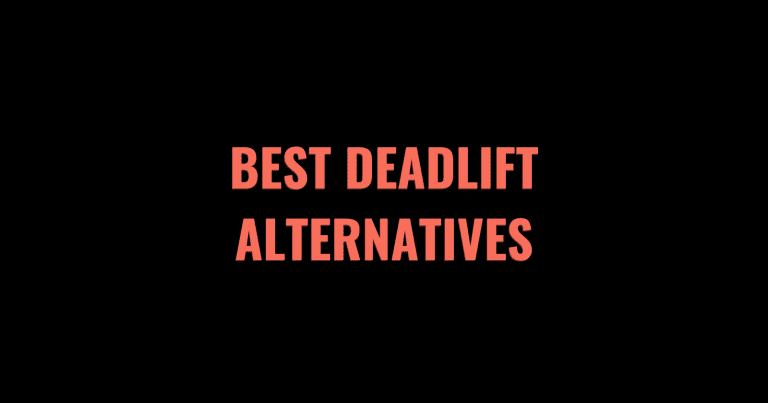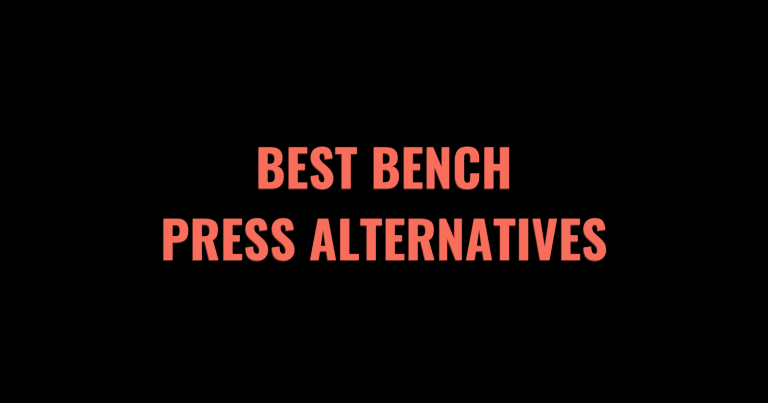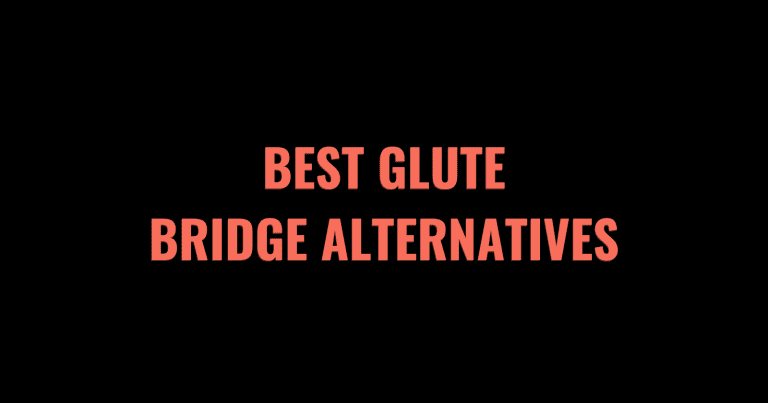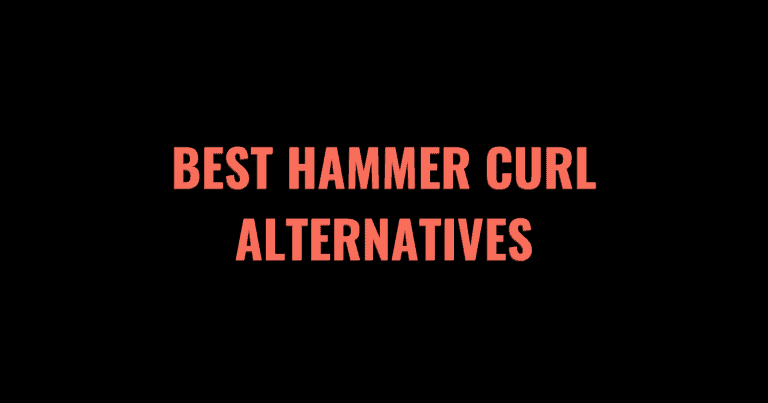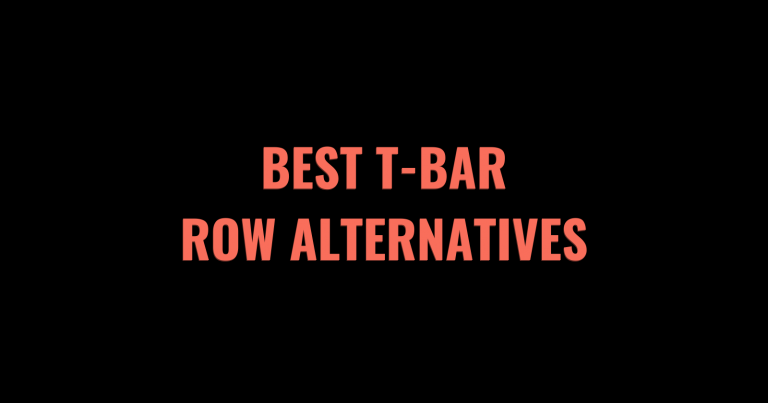The Bulgarian split squat is a very effective exercise for building and strengthening the lower body as well as improving overall balance and stability. Unlike most lower-body exercises, the Bulgarian split squat is a unilateral exercise, meaning that it trains one side at a time. If you have a muscular imbalance, unilateral exercises are the best way to correct the discrepancy.
Although Bulgarian split squats are a phenomenal exercise, there are several other exercises that are just as effective and may be better for you. Below you will find our definitive list of the best Bulgarian split squat alternatives. We cover why each one is included, how to perform them properly, and provide some additional tips on exercise execution.
Regardless of your situation, there’s an exercise in here that you can use as a Bulgarian split squat alternative!
Table of Contents
- 1 The 10 Best Bulgarian Split Squat Alternatives
- 2 Lunges
- 3 Single-Leg Leg Press
- 4 Leg Extensions
- 5 Smith Machine Split Squats
- 6 Back Squats
- 7 Front Squats
- 8 Hip thrusts
- 9 Step-Ups
- 10 Split Squats
- 11 Hack Squats
- 12 Reasons to choose a Bulgarian split squat alternative
- 13 Muscles worked by Bulgarian split squats
- 14 Frequently Asked Questions
- 15 Final Thoughts
- 16 Other Alternative Exercises
- 16.1 The 9 Best Pendlay Row Alternatives
- 16.2 The 10 Best Dumbbell Pullover Alternatives
- 16.3 The 8 Best Decline Bench Press Alternatives
- 16.4 The 8 Best Ab Rollout Alternatives
- 16.5 The 7 Best Deadlift Alternatives
- 16.6 The 10 Best Hack Squat Alternatives
- 16.7 The 10 Best Lat Pulldown Alternatives
- 16.8 The 10 Best Box Jump Alternatives
- 16.9 The 10 Best Bench Press Alternatives
- 16.10 The 10 Best Glute Bridge Alternatives
- 16.11 The 10 Best Pallof Press Alternatives
- 16.12 The 10 Best Bent Over Row Alternatives
- 16.13 The 8 Best Incline Bench Press Alternative
- 16.14 The 8 Best Hammer Curl Alternatives
- 16.15 The 9 Best T-Bar Row Alternatives
The 10 Best Bulgarian Split Squat Alternatives
- Lunges
- Single-Leg Leg Press
- Leg Extensions
- Smith Machine Split Squats
- Back Squats
- Front Squats
- Hip Thrusts
- Step-Ups
- Split Squat
- Hack Squat
Lunges
When to perform lunges
Lunges are a great Bulgarian split squat alternative because they are a unilateral exercise that’s very functional and has good carry-over to other movements. Not to mention there’s a wide variety of lunge variations to choose from. You can do walking lunges, forward lunges, backward lunges. You can also add weight using a barbell, dumbbells, or kettlebells.
Similar to the Bulgarian split squat, by altering the width of your stance, you can emphasize the quads or glutes and hamstrings more. The closer your stance is, the more your quads will be engaged. The wider your stance is, the more your glutes and hamstrings will be activated.
If you have trouble with balance, it’s a good idea to do lunges for an extended period of time to improve your balance and strength before moving up to a Bulgarian split squat. What’s more, lunges will help correct any strength or muscular imbalances you may have.
Lunges are quite the demanding compound exercise, so we recommend doing them near the beginning of a workout.
How to perform lunges
- To do this exercise, all you need is your body, but you can add resistance by holding onto dumbbells or kettlebells, wearing a weighted vest, or by placing a barbell on your upper back.
- Grab a pair of dumbbells with a neutral grip and stand with your feet shoulder-width apart.
- Take a deep breath, then step forward with your right leg while keeping the ball of your left foot on the ground.
- Bend the right knee until it forms a 90-degree angle or the left knee touches the ground.
- Pause for 1-2 seconds, then extend your right leg and bring your left leg forward to stand up.
- Repeat this process with your left leg.
- Continue for the desired number of repetitions and sets.
In the video below from Mind Pump TV, their head trainer, Danny, demonstrates the only way you should be doing lunges!
Lunge tips
- Maintain an upright torso and keep your core engaged throughout the exercise.
- Don’t let the knee of your front leg pass the toes.
- Push through the heel of your front leg to stand up.
- Flat-soled shoes work best for this exercise.
Single-Leg Leg Press
When to perform the single-leg leg press
The single-leg leg press is a great Bulgarian split squat alternative for people seeking some added stability and wanting to isolate the legs a bit more. Since the Bulgarian split squat is a free-weight exercise, it recruits more stabilizer muscles compared to a machine-based exercise.
So if you want to minimize systemic fatigue while still effectively targeting the lower body, a single-leg leg press is a superior option. Furthermore, the leg press machine has built-in safety mechanisms, which makes it safer to train to failure.
You could do a standard leg press, but since a Bulgarian split squat is a unilateral exercise, a single-leg leg press is more comparable. Plus, unilateral exercises are very important for preventing and correcting muscular and strength imbalances. If one leg is stronger than the other, it can increase the risk of injury, have a negative impact on your performance, and result in an asymmetrical physique.
When performing this exercise, start with your weaker leg and let the weak side dictate how much weight and reps you do. The single-leg leg press is best performed near the beginning of a lower-body-focused workout.
How to perform the single-leg leg press
- Adjust the height of the sled to where you can easily un-rack and re-rack the sled with a slight bend in your knee. You may also be able to adjust the angle of the back support pad. If so, place it in a position that feels most comfortable and allows you to get a full range of motion.
- Add an appropriate amount of weight onto each side of the leg press.
- Sit down.Lean back until your torso and head are supported back by the pad.
- Place your right leg in the middle of the platform.
- Un-rack the sled by extending your right leg, then move the racking mechanisms out to the side by rotating the handles outward. Allow your left leg to remain relaxed underneath the sled.
- Take a deep breath, brace your core, and begin to lower the sled towards your body by bending your right leg.
- Once your right leg forms a 90-degree angle, pause for 1-2 seconds.
- Exhale as you push through your right heel to bring the sled back to the starting position.
- Stop just before your right leg is fully extended.
- Repeat for the desired number of repetitions and sets.
Watch the video below from Scott Herman to see how to perform a single-leg leg press correctly!
Single-Leg Leg Press Tips
- Position your foot lower on the platform to engage more of the quads
- Position your foot higher on the platform to target the glutes and hamstrings more.
- Focus on driving through your heel.
- Flat-soled shoes work best for this exercise.
- Don’t lock out your leg at the top of the rep.
Leg Extensions
When to perform leg extensions
Leg extensions are a good Bulgarian split squat alternative for those looking to further isolate their quads. Leg extensions are one of the only exercises that directly target the quads without recruiting other lower body muscles. They aren’t nearly as fatiguing or challenging, so you can add more volume to your quads without negatively impacting your recovery.
You can perform leg extensions one leg at a time, which is recommended if you have a muscular imbalance. Most leg extension machines use a cable, so unlike free weights, they place constant tension on the quads.
Leg extensions adequately work the rectus femoris since that’s the only quad muscle that crosses the hip and knee. Therefore, when you perform a squat or a lunge, the length of the rectus femoris stays relatively the same. Whereas with a leg extension, your hips stay in one place, and only your knee moves, which allows for maximal force production of the rectus femoris.
Since it’s not very demanding, you can perform the leg extension at any point during a workout.
How to perform leg extensions
- Adjust the back support and leg support pad so that the leg support pad is directly in front of your ankle and your knee is at a 90-degree angle when you’re sitting on the machine.
- Select an appropriate amount of weight, sit down on the machine, place your lower leg behind the leg pad, and lean back so that your torso and head are supported.
- Grab the handles on each side of you and pull down to lock yourself into position.
- Take a deep breath, brace your core, and extend your legs to push the leg pad away from you to lift the weight stack.
- Once your legs are fully extended, pause for 1-2 seconds and focus on squeezing your quads.
- Exhale as you lower your legs back to the starting position. Stop just before the weight stack returns to its resting position.
- Repeat for the desired number of repetitions and sets.
In the video below, Jeff Nippards shares his tips and tricks on how to perform the perfect leg extension!
Leg extension tips
- Point your toes straight, inward, or outward to emphasize different areas of the quad.
- Make sure you achieve full extension at the top of every rep.
- Pull down on the handles that are at your sides to keep your body in the right position.
Smith Machine Split Squats
When to perform smith machine split squats
Smith machine split squats are an ideal Bulgarian split squat alternative for anyone wanting to focus on hitting their quads, glutes, and hamstrings, as opposed to balancing. One of the major downfalls of the Bulgarian split squat is that other muscle groups may be a limiting factor instead of your legs, so you never get to fully tax the leg muscles.
Since the smith machine is more stable, it requires less balance, allowing you to put all of your energy into working your lower body. If you’re an athlete, a Bulgarian split squat is arguably more functional, but if you are looking to grow your legs and get stronger, a smith machine is a great tool.
To focus on hypertrophy and achieve a greater range of motion, place a plate under your front leg and perform a front-foot elevated split squat. Furthermore, the smith machine has several positions where you can rack the weight, so you can safely train to failure without a spotter.
Perform this exercise near the beginning of a workout since it is a compound movement. Smith machine split squats make a great precursor to the Bulgarian split squat if you lack the strength, stability, or mobility to execute the exercise properly.
How to perform smith machine split squats
- Adjust the height of the smith machine to just under shoulder level. You should be able to easily un-rack and re-rack the bar with a slight bend in your knees.
- Load an appropriate amount of weight on each side.
- Step under the bar and place it along your upper traps. Grab each side of the bar to help keep it in the correct position. Assume a split stance position by placing one leg forward and one leg backward.
- Unrack the bar by standing up and rotating the bar forward or backward to unlock it.
- Take a deep breath, brace your core, and begin the movement by bending your front leg.
- Once your front leg forms a 90-degree angle and/or your back knee touches the ground, pause for 1-2 seconds.
- Exhale as you drive through the heel of your front leg to return back to the starting position.
- Repeat for the desired number of repetitions and sets, then switch legs.
If you want to see how smith machine split squats are performed, watch the video below!
Smith machine split squat tips
- Start with your weaker leg and perform the same number of reps on the stronger leg.
- Flat-soled shoes work best.
- The majority of your weight should be on your front leg, the back leg should be doing little to no work.
Back Squats
When to perform back squats
Back squats may not be a unilateral exercise, but they effectively build and strengthen the entire lower body. Back squats are a very functional movement, they recruit the most amount of musculature compared to other lower body exercises, and have great carry-over to other movements, including activities of daily living.
Back squats are commonly used as a strength metric, so if you are planning to compete in a strength sport, such as CrossFit, powerlifting, or strongman, back squats should be in your workout routine. Since back squats are a free weight exercise, you aren’t restricted by a machine’s path of motion.
Not to mention, you can emphasize specific muscles by adjusting your stance. If you use a close-stance with your toes pointed forward, the quads will be more engaged. On the other hand, you can do a wide stance with your toes pointed out to hit the glutes and hamstrings more. You can even do heel elevated squats to increase the range of motion and target the quads.
Back squats are a phenomenal exercise that should be done if you can do them properly. Perform them at the beginning of a workout since they are so physically demanding. If you don’t have access to a barbell, you can do goblet squats with a dumbbell, medicine ball, or kettlebell.
How to perform back squats
- To do this exercise, you will need an Olympic barbell, Olympic plates, and a squat rack.
- Set up the barbell to just below shoulder height. Position the safety bars just below the bottom of your squat. You should be able to easily un-rack and re-rack the barbell without going on your toes or excessively bending your legs.
- Place the barbell on the rack, add an appropriate amount of weight to each side, and secure the weight with clips.
- Step under the barbell and place it along your upper traps. Retract your shoulder blades, contract your lats, and grab each side of the barbell with a pronated grip to help hold it into position.
- Unrack the barbell by standing up and taking 2-3 steps backward.
- Assume a shoulder-width stance with your toes pointed slightly out.
- Take a deep breath, brace your core, and begin to squat by pushing your hips slightly back as you bend your knees.
- Once your hips pass just below parallel and/or your knees form a 90-degree angle, pause for 1-2 seconds.
- Exhale as you drive through your heels and mid-foot to stand back up.
- At the top of the rep, squeeze your glutes, quads, and hamstrings.
- Repeat for the desired number of repetitions and sets.
In the video below, Jeff Nippard explains how to barbell back squat with perfect technique!
Back squat tips
- Flat-soled or Olympic weightlifting shoes work best.
- Maintain a neutral spine by looking straight ahead.
- Avoid letting your knees cave in, especially on the concentric portion of the lift.
Front Squats
When to perform front squats
Front squats provide many of the same benefits as back squats and Bulgarian split squats, except they recruit the quads to a much greater extent. As the name suggests, front squats are performed with the weight loaded on the front of your shoulders, so the upper back and quads are primarily responsible for executing the movement.
Front squats are very functional, but they require more shoulder, wrist, ankle, and hip mobility than many other lower body exercises. Since they translate very well to the clean & jerk as well as the snatch, front squats are very popular among CrossFitters and Olympic weightlifters.
If you cannot perform a front squat with a traditional Olympic weightlifting grip, try some other variations. Front squats are ideal for those that want to build and strengthen their quads as opposed to their glutes and hamstrings. You can even elevate your heels to further tax the quads. Perform front squats at the beginning of a workout since they are very physically demanding.
How to perform front squats
- To do this exercise, you will need an Olympic barbell, squat rack, Olympic plates, and weight clips.
- Set the squat rack to just below shoulder level and adjust the safety bars according to your squat depth. You should be able to easily un-rack the barbell without going on your toes or squatting too far down,
- Place the barbell on the rack and load an appropriate amount of weight on each side, then secure the weight with clips.
- Stand facing the bar, and place your hands on the bar about shoulder-width apart. Bend your arms, bring your elbows up until they are nearly parallel with the floor, and place the barbell across your front delts. You should have 2-3 fingers under the bar.
- Unrack the barbell by standing up and taking 2-3 steps backward. Assume a shoulder-width stance with your toes slightly pointed out.
- Take a deep breath, brace your core, keep your chest and elbows up, and begin the movement by slightly pushing your hips back and bending your knees.
- Once your hips pass just below parallel, pause for 1-2 seconds.
- Exhale as you drive through your heels and mid-foot to stand back up. Don’t let your knees cave in as you stand up.
- At the top of the rep, squeeze your quads, then repeat for the desired number of repetitions and sets.
For a barbell front squat exercise demonstration check out the video from Jeff Nippard below!
https://www.youtube.com/watch?v=v-mQm_droHg
Front squat tips
- Elevate your heels to increase the range of motion and emphasize the quads.
- Keep your elbows up the entire movement.
- Don’t let your knees cave in, especially on the concentric portion of the lift.
Hip thrusts
When to perform hip thrusts
Hip thrusts are one of the most popular posterior chain exercises because they directly target the hamstring and glute muscles. We added this exercise as a Bulgarian split squat alternative for those that want to emphasize their glutes and hamstrings, as opposed to their quads.
The hip thrust has good carry-over to any other exercise that involves hip extension, including squats and deadlifts. The glutes, more specifically the gluteus maximus, are the strongest and largest muscle in the body. They play a major role in various movements, including walking, running, and jumping.
Having strong glutes is very advantageous for athletic performance and other activities of daily living. If you don’t have access to a barbell or hip thrust machine, you can still perform glute bridges. Do hip thrusts near the beginning of a workout since they are a compound movement.
How to perform hip thrusts
- To do this exercise, you will need an Olympic barbell, Olympic plates, weight clips, a hip thrust pad, and a flat or adjustable bench.
- Load an appropriate amount of weight on each side of the barbell and secure it with the weight clips, then place the hip thrust pad in the middle of the barbell.
- Move the barbell near a flat or adjustable bench so that it’s parallel to the bench.
- Sit down on the floor with your upper back against the bench and your legs flat on the floor.
- Roll the barbell up to hip level, and bend your legs until your feet are flat on the floor about shoulder-width apart. Grab each side of the barbell with a pronated grip to help stabilize the bar.
- Take a deep breath, brace your core, posteriorly rotate your pelvis then thrust your hips up and forward to raise the barbell off of the ground while keeping your upper back braced against the bench.
- Once you reach full hip extension, squeeze your glutes and hold for 1-2 seconds.
- Slowly lower the barbell back to the starting position.
- Repeat for the desired number of repetitions and sets.
In the video below, Bret “Glute Guy” Contreras demonstrates how to properly perform a hip thrust!
Hip thrust tips
- Your shins should be nearly vertical at the top of the rep.
- Keep your rib cage down throughout the movement.
- Drive through your heels to encourage maximal glute recruitment.
Step-Ups
When to perform step-ups
The step-up is a functional compound unilateral exercise that helps improve lower body strength, muscularity, and overall balance. Step-ups have a very similar movement pattern to the Bulgarian split squat, so they train the exact same muscles. Compared to a lunge, the step-up removes the involvement of the rear foot entirely. You’re forced to lift all of the weight up with only one leg.
This movement pattern is great for correcting and preventing muscular imbalances. Very minimal equipment is involved and you can easily add load by using a barbell, weighted vest, dumbbells, or kettlebells. Step-ups are often performed by athletes because they have a lot of carry-over to various movements, including running, sprinting, jumping, etc.
Step-ups also can be a lot easier on your spine compared to a squat because you can hold dumbbells at your sides to add resistance rather than placing a barbell on your back. Since step-ups are quite challenging, Start with just your body weight and do them near the beginning of a workout.
How to perform step-ups
- To do this exercise, you will need a box or flat bench as well as dumbbells or kettlebells.
- Grab a pair of dumbbells with a neutral grip. Stand with a shoulder-width stance facing the box or flat bench.
- Take a deep, brace your core, and raise your right foot on top of the bench or box.
- Exhale as you drive through your heel to raise your left foot off the ground and stand up on the box or bench.
- Once you reach full extension, slowly lower your left leg back to the ground by bending your right leg.
- Then, bring the right leg back to the ground.
- Switch legs and repeat for the desired number of repetitions and sets.
Check out the video below to see how to perform step-ups correctly!
Step-up tips
- Start with your weaker leg.
- Keep your core tight throughout the movement.
- Start with your bodyweight only to perfect the form before adding weight.
Split Squats
When to perform split squats
People often get split squats and Bulgarian split squats confused. Although they sound and look similar, there’s a key difference between the two that make Bulgarian split squats a bit more challenging.
During a Bulgarian split squat, your rear foot is elevated off the ground, so you are required to balance on the front leg. On the other hand, when performing a traditional split squat, you’re in a split stance but your rear foot is still in contact with the ground, making it easier to execute.
If you are struggling to perform a Bulgarian split squat due to balance, or you’ve been doing them for a while and are looking to switch things up, then try out split squats! It’s a good idea to do split squats near the beginning of a workout when you’re fresh.
How to perform split squats
- Grab a pair of dumbbells or kettlebells with a neutral grip.
- Assume a split stance (one foot forward and one foot backward).
- Take a deep breath, brace your core, look straight ahead, and begin the movement by bending your front leg.
- Keep going until your back knee touches the ground and your front leg forms a 90-degree angle, then pause for 1-2 seconds.
- Exhale as you drive through the heel and midfoot of your front foot to return to the starting position. Your back food should remain in the same spot throughout the movement.
- Repeat for the desired number of repetitions, then switch legs.
In the video below, E3 Rehab demonstrates how to do a split squat correctly!
Split squat tips
- To further emphasize the quads, do front foot elevated split squats.
- The front foot should be doing almost all of the work.
- Flat-soled shoes work best for this exercise.
Hack Squats
When to perform hack squats
The last exercise on our best Bulgarian split squat alternatives list is the tried and true hack squat. Similar to a leg press, the hack squat enables you to train the lower body with minimal upper body involvement. Your upper body is completely supported during a hack squat, so it places less strain on the spine and recruits fewer stabilizer muscles.
Since your body is relatively upright during a hack squat, it closely mimics a front squat; therefore, more tension is placed on the quads. There are built-in safety mechanisms as well, which allow you to train to failure without needing a spotter.
Hack squats are a very effective exercise for building and strengthening the lower body; however, not every gym has a hack squat machine. If you happen to have access to one, we highly recommend trying it out! The hack squat is best performed near the beginning of a workout.
How to perform hack squats
- Adjust the height of the sled to where you can un-rack it with a slight bend in your knees.
- Load an appropriate amount of weight on each side of the sled.
- Step onto the platform, assume a shoulder-width stance with your toes pointed out, and place your back, shoulders, and head against the support pads.
- Unrack the sled by lifting it up and moving the safety bars out of the way by rotating the handles that are positioned at your sides outward.
- Take a deep breath, brace your core, and begin the movement by bending your knees.
- Once your knees form a 90-degree angle, pause for 1-2 seconds.
- Exhale as you drive through your heels and mid-foot to push the sled back to the starting position. Avoid locking out your knees at the top.
- Repeat for the desired number of repetitions and sets.
In the video below, Mike Israetel from Renaissance Periodization goes over the proper way to perform a hack squat and 9 common mistakes to avoid!
Hack squat tips
- Using a closer stance that’s lower on the platform challenges the quads even more.
- It’s not necessary, but you can use a weightlifting belt to help with bracing.
- Flat-soled shoes are ideal for this exercise.
Reasons to choose a Bulgarian split squat alternative
Bulgarian split squats are one of the best leg exercises you can do, so why would you choose an alternative? Regardless of how great an exercise may look on paper, there are several reasons why a different exercise may give you even better results.
They say variety is the spice of life and that even applies to the gym. If you always do Bulgarian split squats, and rarely switch things up, your body will have no reason to adapt. Every once in a while, providing your body with a novel stimulus through exercise variation may be just what you need to spark some new growth or strength gains.
Bulgarian split squats are extremely challenging to execute due to the balancing component, so they aren’t very appropriate for beginners. Performing squats, lunges, and split squats is a better starting point.
Some other reasons for seeking a Bulgarian split squat alternative include physical limitations (i.e. you have an injury that prevents you from doing them correctly), equipment limitations (i.e. you don’t have access to the proper equipment, and/or you want to isolate a specific muscle.
Muscles worked by Bulgarian split squats
Bulgarian split squats primarily target the quads, glutes, and hamstrings, but they also engage the core, calves, and forearms.
Primary
- Quads
- Rectus femoris
- Vastus lateralis
- Vastus medialis
- Vastus intermedius
- Hamstrings
- Biceps femoris short head
- Biceps femoris long head
- Semitendinosus
- Semimembranosus
- Glutes
- Gluteus maximus
- Gluteus minimus
- Gluteus medius
Secondary
- Core
- Calves
- Gastrocnemius
- Soleus
- Forearms (if holding onto dumbbells or kettlebells)
Frequently Asked Questions
Is the Bulgarian split squat necessary?
The Bulgarian split squat is an effective lower body exercise, but it’s not necessary for building and strengthening your legs. As we’ve covered in this article, there are several other exercises that target the same muscles, therefore they can be used instead of a Bulgarian split squat.
With that said, perform some type of unilateral exercise for the lower body to prevent developing muscular imbalances and to improve overall balance. That doesn’t mean you have to do a Bulgarian split squat. You could do a lunge variation, single-leg leg press, or even a traditional split squat.
Why are Bulgarian split squats so hard?
Bulgarian split squats are often quite challenging because of the balance component. Even though the Bulgarian split squat is mainly a lower body exercise, there are several stabilizer muscles that engage when performing the movement.
As you add load, it becomes even more challenging to do the exercise while staying in the proper position. Fortunately, the more you do the exercise, the better you’ll get, so stick with it!
Are Bulgarian split squats for quads or hamstrings?
Bulgarian split squats are great for targeting quads, glutes, and hamstrings. If you want to emphasize one muscle group over the other, adjust your stance.
The closer stance you use, the more you’ll target the quads. If you use a wide stance, the glutes and hamstrings will be more engaged. Either way, the Bulgarian split squat works the entire lower body, including the core.
Final Thoughts
Regardless of what exercise you perform, you’re going to see results if you have proper form and apply progressive overload. Every exercise has its own unique benefits and disadvantages. Before ruling an exercise in or out, it’s important to assess if the exercise aligns with your goals, abilities, and equipment selection.
As you can see from this article, the Bulgarian split squat can be easily replaced by a number of exercises. However, the best exercise substitution depends on the person. When it comes to building muscle and gaining strength, there really is no set list of exercises that you have to do, which is what also makes it fun!
Try out some of the Bulgarian split squat alternatives we’ve highlighted above and see which one you like best!
Other Alternative Exercises
If you enjoyed this post, check out our other roundups of the best alternatives for other exercises.




